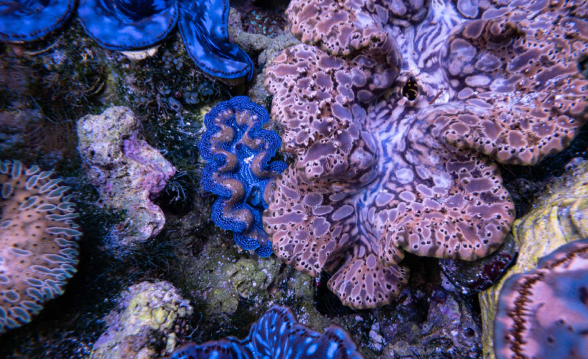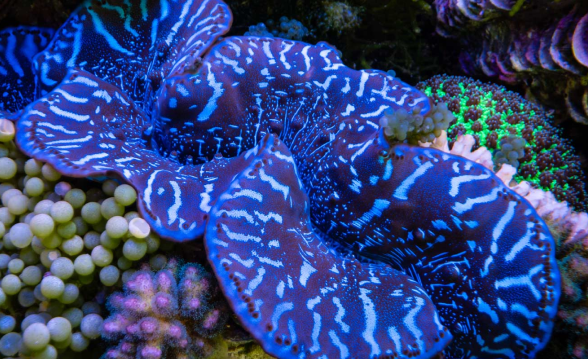The History of Understanding Giant Clams


Early discoveries and taxonomic classification
Giant clams were first described scientifically in the 18th century during a period of extensive exploration and documentation of the natural world. The first formal description of a giant clam species was made by the renowned Swedish naturalist Carl Linnaeus in 1758. Linnaeus described Tridacna gigas, the largest of all giant clam species, in his seminal work Systema Naturae. This classification marked the official beginning of scientific inquiry into giant clams, setting the foundation for future research.
Over the following centuries, additional species of giant clams were identified and described. Each discovery expanded our understanding of their diversity and distribution. The genus Tridacna now includes at least 13 species (Neo et al., 2015), each with unique characteristics and ecological roles within coral reef ecosystems.

Understanding symbiosis and photosynthesis
One of the most significant breakthroughs in the study of giant clams came with the discovery of their symbiotic relationship with photosynthetic algae, known as zooxanthellae. This relationship, first observed in the late 19th and early 20th centuries, revealed that giant clams harbor these microscopic algae within their tissues. The algae perform photosynthesis, converting sunlight into energy, which is then shared with the clam. This symbiotic relationship provides the clam with a substantial portion of its nutritional requirements, enabling it to grow and thrive in nutrient-poor coral reef environments. Corals also have a symbiotic relationship with these algae and this allows them to form the foundation of reef structures.
The discovery of zooxanthellae symbiosis was a pivotal moment in marine biology, as it highlighted the complex and interconnected nature of coral reef ecosystems. It also explained how giant clams (and corals) could achieve such large sizes while residing in relatively nutrient-poor waters. This relationship is now recognized as one of the key factors contributing to the ecological success of giant clams.
Understanding growth and size
Giant clams are known for their impressive size, with Tridacna gigas capable of reaching lengths of over 1.2 meters (4 feet) and weighing up to 200 kilograms (440 pounds). Accordingly, the study of their growth patterns and the factors influencing their size has been an important area of research. In the mid-20th century, scientists began to investigate the growth rates of giant clams, discovering that their size is not solely dependent on age but also on environmental factors such as light availability, water temperature, and nutrient levels.
Research in the 1970s and 1980s provided insights into the mechanisms behind their growth, particularly the role of calcium carbonate deposition in shell formation. It was found that giant clams secrete calcium carbonate to build their shells, a process that continues throughout their lives. This discovery furthered our understanding of their role in reef building and maintenance, as their shells contribute significantly to the structural complexity of coral reefs.

Conservation concerns and understanding ecological significance
As our understanding of giant clams grew, so did awareness of their ecological importance and the threats they face. Giant clams are considered keystone species in coral reef ecosystems, meaning their presence and activities have a disproportionately large impact on their environment. They contribute to reef structure, provide habitats for other marine organisms, and play a role in nutrient cycling.
However, by the late 20th century, giant clams were facing significant pressures from overfishing, habitat destruction, and climate change. Their large size and slow growth rates made them particularly vulnerable to exploitation. In response, conservation efforts were initiated, including the establishment of marine protected areas and the development of aquaculture programs aimed at replenishing wild populations.
One notable breakthrough in giant clam conservation was the successful breeding and rearing of clams in captivity. Researchers developed techniques for spawning and growing juvenile clams in controlled environments, which were then reintroduced into the wild. These efforts have helped stabilize some populations and have provided valuable insights into the biology and life cycle of giant clams.
Recent research and potential future directions
In recent years, research on giant clams has expanded to explore their potential in addressing global environmental challenges. Here at the IMARCS Foundation, we are investigating the role of giant clams in storing carbon and potentially mitigating some impacts associated with climate change. Additionally, we are currently investigating their ability to filter large volumes of water and how this could help remove microsplastics.
Today, giant clams continue to be a subject of fascination and study. Their long history with humans - from pre-scientific discovery to early taxonomic classification to cutting-edge research - underscores their importance in marine ecosystems and highlights the need for continued conservation efforts to protect these remarkable organisms.
References:
Neo, M. L., Eckman, W., Vicentuan, K., Teo, S. L. M., & Todd, P. A. (2015). The ecological significance of giant clams in coral reef ecosystems. Biological Conservation, 181, 111-123.
Rosewater, J. (1965). The Family Tridacnidae in the Indo-Pacific. Indo-Pacific Mollusca, 1(6), 347-396.
Lucas, J. S., & Nash, W. J. (1983). Spawning and growth of the giant clam, Tridacna gigas (L.). Aquaculture, 31(3-4), 181-201.
Govan, H. (1993). The ecological and cultural significance of giant clams in the Indo-Pacific. Pacific Science, 47(3), 318-330.
Fitt, W. K., Fisher, C. R., & Trench, R. K. (1986). Contribution of the symbiotic dinoflagellate Symbiodinium microadriaticum to the carbon budget of the giant clam Tridacna gigas. Marine Biology, 91(3), 423-432.